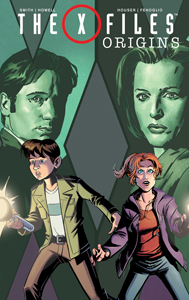It’s become fashionable in the last decade or so to try to draw new fans into old franchises. Toward that end, you might as well start them young: Hence, we have “X-Files: Origins” (2016), a four-issue young-adult series in which each issue is a flip-comic – half is Mulder’s story, half is Scully’s. So it’s two issues’ worth of story for each teenage future-agent. The series was popular enough to warrant a sequel in the same format, 2017’s “Dog Days of Summer.”
Mulder’s Story (2016)
Written by Jody Hauser, Mulder’s story is set in 1974 in his hometown of Martha’s Vineyard, Mass., where his friends for that summer are Eric and Tim. (As Fox notes in a nice insight into vacationland kids, they might not be his friends next summer, but he’s happy to have them this summer.) The art by Chris Fenoglio is bright and colorful, and it’s easy to tell which kid is Mulder even though he doesn’t strikingly look like Mulder.
Mulder’s life doesn’t lend itself well to a kid-friendly story. His first mystery obsession is the disappearance of his sister, Samantha, the previous November. He isn’t into aliens and government cover-ups yet (that will kick in a few years later in the novel “Origins: Agent of Chaos”).

“Origins” (2016) and “Origins: Dog Days of Summer” (2017)
Series: “The X-Files”
Publisher: IDW
Writers: Jody Hauser, Matthew Dow Smith
Artists: Chris Fenoglio, Corin Howell, Monica Kubina
So while this story does include alien goo, spaceship wreckage and a dazed American test pilot, he doesn’t get hooked by that stuff as much as Tim and Eric do. Through thoughts that Fox doesn’t share with his buddies, we see that he’s morose over failing to protect/find Samantha, and he’s gradually learning that he can’t trust adults, namely his own father.
The yarn perks up for a moment with the appearance of a corporeal ghost girl who tells Mulder to keep looking into this case. No explanation is given for the girl, although by glancing at the other half of the books, I see she’s also in the Scully story, so maybe I’ll learn more there.
There’s nothing wrong with Mulder’s story in terms of tone or continuity, but it does have the problem of failing to justify its existence. This is pretty downbeat stuff for young readers, and too simple and unsurprising for adults. Even the final-panel reveal of the Cigarette Smoking Man is entirely rote.
“The X-Files” can translate to young fans (tons of YA episode adaptation novels were put out back in the day, and the two “Origins” novels are good), but judging by this story alone, one would assume this is unfertile territory.
2.5 stars
Scully’s Story (2016)
Writer Matthew Dow Smith makes a case that Scully is better minus Mulder than Mulder is minus Scully. Again, we have a simple story – this one taking place in the summer of 1977 in San Diego, where William Scully Sr. is stationed as a Navy rear admiral.

Dana’s Sunday school teacher Mr. Wilson is murdered, and she wants both physical and philosophical answers, unimpressed by the police’s lack of progress and seeming lack of caring. Again, we get big colorful panels, this time from Corin Howell (art) and Monica Kubina (colors). The young Scully likeness is good, helped along by her fiery red hair.
William Sr., at least at this point, is not in deep with the Syndicate, so this is actually the story where that begins. He finds the base’s requisitions books don’t add up, and in the end the CSM has a little chat with him about that.
Although the whole Scully family makes an appearance or – in the case of infant Charlie – gets a shout-out, this story finds Dana mostly as a loner. In thought bubbles, she compares herself to Nancy Drew (as does a police detective annoyed with her snooping) and draws upon what she’s learned from Sherlock Holmes, Poirot and Miss Marple, as well.
Scully’s one friend and helper is a girl named Mercy, who I think is also the corporeal ghost from the Mulder story. To the villain of the piece, Mercy appears as an angel. We don’t learn why, but there is an “Origins” sequel coming down the pike, so maybe answers are yet to be found. Another nice crossover from the Mulder story comes in the form of Eric’s dad, who warns William Sr. about the Syndicate in vague terms.
This is more engaging than the Mulder story, because Scully is more of a fully formed person earlier in her life than Mulder is. And it’s just plain less depressing, since Dana has good relationships with her family members. But it’s still a lightly plotted young-adult yarn that doesn’t feel all that essential to the grand X-Files story.
3.5 stars

“Dog Days of Summer”: Mulder’s Story (2017)
I like the second go-around with young Fox better, just because I got into the rhythms, but this is more of the same, taking place one week after the previous adventure (and again penned by Hauser). This time, a deaf girl, Lisa, is drawn into Mulder’s sphere, leading to a good Tim line that presages Fox’s future effortlessness with the ladies: “Seriously, do you just find girls everywhere?”
We also sort of get an answer about Mercy. Yes, she’s the same girl from the Scully story, and yes, she’s a supernatural force of some kind, as she seems to rescue Lisa from the governmental bad guys using her supernatural powers. Maybe Hauser planned for more answers in a third volume that never came about. Or maybe this is just another one of those X-Files that will never be fully answered (cue the theme music).
3 stars
“Dog Days of Summer”: Scully’s Story (2017)
It strikes me again that young Dana feels more like a complete person than young Fox. Lost in her own thoughts even more than Fox is (Mercy eventually shows up again, but she’s not as present as Fox’s two buddies are), Dana continues to mull why God would take away Mr. Wilson and why He lets more bad things happen such as the trigger for this latest mystery: a plane crash in San Diego. She’s also peeved that adults never listen to kids.
Dana’s determination to get answers is again on fine display, and her interactions with her dad are strong, especially in an amusing scene where the elder Scully curses her out and she sits unmoving on the end of her bed – although readers are privy to her thought bubbles. These Dana origin stories have essentially become “Nancy Drew” mysteries, except without a supportive father and with wider stakes.
Howell does especially nice work on one page wherein Dana retreats from the bright living room through the dark parts of the house to her bedroom. It nicely illustrates the isolation she feels, along with the way houses feel big to kids.
Because Smith makes William Scully Sr. into an active player in the drama – someone who stands up to corruption on his naval base, a contrast to the more timid (but also more aware) Bill Mulder – this story has some heft to it. Unfortunately, it kind of peters out at the end. That’s common with “X-Files” stories, but it’s always slightly more of a letdown in comics than on TV.
A case could be made that young Mulder and Scully shouldn’t be so close to Syndicate conspiracies. Maybe those should’ve been saved for their adult lives and they could’ve closed some kid-oriented cases in “Origins.”
3.5 stars

